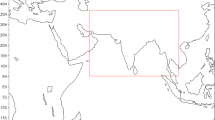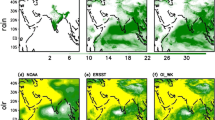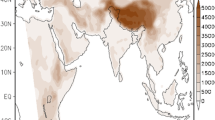Abstract
In this study, a smaller domain over India alone and a larger South Asia (SA) domain have been used in the Regional Climate Model version 4.2 (RegCM4.2) to examine the effect of the domain size on the Indian summer monsoon simulations. These simulations were carried out over a period of 36 years at 50 km horizontal resolution with the lateral boundary forcings of the UK Met Office Hadley Centre Global Circulation Model Version 2.0. Results show that the Indian summer monsoon rainfall is significantly reduced when the domain size for the model integration is reduced from SA to the Indian domain. In case of SA domain simulation, the Equitable Threat Scores have higher values in case of very light, light and moderate rainfall events than those in case of the Indian domain simulation. It is also found that the domain size of model integration has dominant impact on the simulated convective precipitation. The cross-equatorial flow and the Somali Jet are better represented in the SA simulation than those in the Indian domain simulation. The vertically integrated moisture flux over the Arabian Sea in the SA domain simulation is close to that in the NCEP/NCAR reanalysis while it is underestimated in the Indian domain simulation. It is important to note that when RegCM4.2 is integrated over the smaller Indian domain, the effects of the Himalayas and the moisture advection from the Indian seas are not properly represented in the model simulation and hence the monsoon circulation and associated rainfall are underestimated over India.











Similar content being viewed by others
References
Adler RF, Huffman GJ, Chang A, Ferraro R, Xie P, Janowiak J et al (2003) The version 2 global precipitation climatology project (GPCP) monthly precipitation analysis (1979–present). J Hydrometeorol 4:1147–1167
Anthes RA, Kuo Y-H, Hsie E-Y, Low-Nam S, Bettge TW (1989) Estimation of skill and uncertainty in regional numerical models. Q J R Meteorol Soc 115(488):763–806
Ashfaq M, Shi Y, Tung WW, Trapp RJ, Gao XJ, Pal JS, Diffenbaugh NS (2009) Suppression of south Asian summer monsoon precipitation in the 21st century. Geophys Res Lett 36:L01704. doi:10.1029/2008GL036500
Bhaskaran B, Jones RG, Murphy JM, Noguer M (1996) Simulations of the Indian summer monsoon using a nested regional climate model: domain size experiments. Clim Dyn 12:573–587
Bhaskaran B, Ramachandran A, Jones R, Moufouma-Okia W (2012) Regional climate model applications on sub-regional scales over the Indian monsoon region: the role of domain size on downscaling uncertainty. J Geophys Res 117. ISSN: 0148-0227. doi:10.1029/2012JD017956
Browne NAK, Sylla MB (2012) Regional climate model sensitivity to domain size for the simulation of the West African monsoon rainfall. Int J Geophys, 625831. doi:10.1155/2012/625831
Collins WJ et al (2011) Development and evaluation of an earth-system model HadGEM2. Geosci Model Dev 4:997–1062
Dash SK, Shekhar MS, Singh GP (2006) Simulation of Indian summer monsoon circulation and rainfall using RegCM3. Theoret Appl Climatol 86(1–4):161–172
Dash SK, Sharma N, Pattnayak KC, Gao XJ, Shi Y (2012) Temperature and precipitation changes in the north-east India and their future projections. Global Planet Change 98–99:31–44
Dash SK, Mamgain A, Pattnayak KC, Giorgi F (2013) Spatial and temporal variations in Indian summer monsoon rainfall and temperature: an analysis based on RegCM3 simulations. Pure appl Geophys 170:655–674
Denis B, Laprise R, Caya D, Cote J (2002) Downscaling ability of one-way nested regional climate models: the Big-Brother Experiment. Clim Dyn 18:627–646
Denis B, Laprise R, Caya D (2003) Sensitivity of a regional climate model to the spatial resolution and temporal updating frequency of lateral boundary conditions. Clim Dyn 20:107–126
Dickinson RE, Henderson-Sellers A, Kennedy PJ (1993) Biosphere-atmosphere transfer scheme (bats) version1e as coupled to the NCAR community climate model, Technical report, National Center for Atmospheric Research
Ding Y (2004) Seasonal march of the East-Asian summer monsoon. In: Chang CP (ed) East Asian Monsoon. World Scientific, Singapore, p 564
Elguindi N, Bi XQ, Giorgi F et al (2011) Regional climatic model RegCM user mannual version 4.1. The Abdus Salam International Centre for Theoretical Physics Strada Costiera, Trieste
Emanuel KA (1991) A scheme for representing cumulus convection in large-scale models. J Atmos Sci 48(21):2313–2335
Emanuel KA, Zivkovic-Rothman M (1999) Development and evaluation of a convection scheme for use in climate models. J Atmos Sci 56:1766–1782
Fasullo J, Webster PJ (2003) A hydrological definition of Indian monsoon onset and withdrawal. J Clim 16(14):3200–3211
Findlater J (1969) A major low-level air current near the Indian Ocean during the northern summer. Q J R Meteorol Soc 95:362–380
Fritsch JM, Chappell CF (1980) Numerical prediction of convectively driven mesoscale pressure systems. Part I: convective parameterization. J Atmos Sci 37:1722–1733
Gao XJ, Shi Y, Zhang DF et al (2012) Uncertainties of monsoon precipitation projection over China: results from two high resolution RCM simulations. Clim Res 52:213–226
Giorgi F, Mearns LO (1999) Introduction to special section: regional climate modeling revisited. J Geophys Res 104:6335–6352
Giorgi F, Marinucci MR, Bates GT (1993a) Development of a second generation regional climate model (RegCM2). Part I: boundary-layer and radiative transfer processes. Mon Weather Rev 121:2794–2813
Giorgi F, Marinucci MR, Bates GT, De Canio G (1993b) Development of a second- generation regional climate model (RegCM2). Part II: convective processes and assimilation of lateral boundary conditions. Mon Weather Rev 121:2814–2832
Giorgi F, Diffenbaugh NS, Gao XJ, Coppola E, Dash SK, Frumento O, Rauscher SA, Remedio A, Sanda IS, Steiner A, Sylla B, Zakey AS (2008) The regional climate change hyper-matrix framework. Eos 89(45):445–456
Giorgi F et al (2012) RegCM4: model description and illustrative basic performance over selected CORDEX domains. Clim Res 52:7–29
Giorgi F, Coppola E, Raffaele F et al (2014) Changes in extremes and hydroclimatic regimes in the CREMA ensemble projections. Clim Change 125:39–51
Grell GA (1993) Prognostic evaluation of assumptions used by cumulus parameterizations. Mon Weather Rev 121:754–787
Holtslag AAM, de Bruijn EIF, Pan H-L (1990) A high resolution air mass transformation model for short-range weather forecasting. Mon Weather Rev 118:1561–1575
Jones RG, Murphy JM, Noguer M (1995) Simulation of climate change over Europe using a nested regional-climate model. I: assessment of control climate, including sensitivity to location of lateral boundaries. Q J R Meteorol Soc 121(526):1413–1449
Kalnay E, Kanamitsu M, Kistler R, Collins W, Deaven D, Gandin L, Iredell M, Saha S, White G, Woollen J, Zhu Y, Chelliah M, Ebisuzaki W, Higgins W, Janowiak J, Mo KC, Ropelewski C, Wang J, Leetmaa A, Reynolds R, Jenne R, Joseph D (1996) The NMC/NCAR 40-Year Reanalysis Project. Bull Am Meteorol Soc 77:437–471
Keshavamurthy RN, Sankara Rao MS (1992) The physics of monsoons. Allied Publishers Ltd, New Delhi
Kiehl JT, Hack JJ, Bonan GB, Boville BA, Breigleb BP, Williamson D, Rasch P (1996) Description of the ncar community climate model (ccm3), Technical Report of NCAR/TN-420? STR, National Center for Atmospheric Research
Kistler R et al (2001) The NCEP–NCAR 50-year reanalysis: monthly means CD-ROM and documentation. Bull Am Meteorol Soc 82:247–268
Koteswaram P (1958) The easterly jet stream in the tropics. Tellus 10:43–57
Li WP (1999) Moisture flux and water balance over the South China Sea during late boreal spring and summer. Theor Appl Climatol 641:179–187
May W (2002) Simulated changes of the Indian summer monsoon under enhanced greenhouse gas conditions in a global time-slice experiment. Geophys Res Lett 29(7):1118. doi:10.1029/2001GL013808
Meehl GA, Arblaster JM (2003) Mechanisms for projected future changes in south Asian monsoon precipitation. Clim Dyn 21:659–675
Murakami T, Nakazawa T, He T (1984) On the 40–50 day oscillation during the 1979 northern hemisphere summer. Part II: heat and moisture budget. J Meteorol Soc Jpn 62:469–484
Pattnayak KC, Panda SK, Dash SK (2013) Comparative study of regional rainfall characteristics simulated by RegCM3 and recorded by IMD. Global Planet Change 106:111–122
Pisharoty PR (1965) Evaporation over the Arabian Sea and the Indian Southwest Monsoon. In: Proceedings of International Indian Ocean Expedition, P. R. Pisharoty, Ed., pp 43–54
Raghavan K (1973) Tibetan anticyclone and tropical easterly jet. Pure appl Geophys 110:2130–2142
Rajeevan M, Bhate Jyoti (2009) A high resolution daily gridded rainfall dataset (1971–2005) for mesoscale meteorological studies. Curr Sci 96(4):558–562
Ratnam JV, Giorgi F, Kaginalkar A, Cozzini S (2009) Simulation of the Indian monsoon using the RegCM3-ROMS regional coupled model. Clim Dyn 33:119–139
Saha KR, Bavadekar SN (1973) Water vapour budget and precipitation over the Arabian Sea during the northern summer. Q J R Mereorol Soc 99:273–278
Schaefer JT (1990) The critical success index as an indicator of warning skill. Weather Forecast 5:570–575
Shekhar MS, Dash SK (2005) Effect of Tibetan spring snow on the Indian summer monsoon circulation and associated rainfall. Curr Sci 88:1840–1844
Singh GP, Oh JH (2007) Impact of Indian Ocean sea-surface temperature anomaly on Indian summer monsoon precipitation using a regional climate model. Int J Climatol 27:1455–1465
Sperber KR, Palmer TN (1996) Interannual tropical rainfall variability in general circulation model simulations associated with the atmospheric model inter-comparison project. J Clim 9:2727–2750
Sundqvist H, Berge E, Kristjansson JE (1989) The effects of domain choice on summer precipitation simulation and sensitivity in a regional climate model. J Clim 11:2698–2712
Zeng X (2005) A prognostic scheme of sea surface skin temperature for modeling and data assimilation. Geophys Res Lett 32:l14605
Zeng X, Zhao M, Dickinson RE (1998) Intercomparison of bulk aerodynamic algorithms for the computation of sea surface fluxes using TOGA COARE and TAO data. J Clim 11:2628–2644
Zhang DF, Gao XJ, Ouyang LC (2008) Simulation of present climate over China by a regional climate model. J Trop Meteorol 14:19–23
Acknowledgments
The authors are thankful to the organizations from which datasets are obtained for conducting this study. The initial and boundary conditions to integrate RegCM4.2 are obtained from the Abdus Salam International Centre for Theoretical Physics (ICTP) website http://clima-dods.ictp.it/data/d8/cordex/HadGEM2/. The gridded rainfall data have been obtained from the India Meteorological Department (IMD). The atmospheric fields are obtained from the NCEP/NCAR reanalyzed dataset. Thanks are due to Dr. Erika Coppola, Mr. Graziano Giuliani and Mr. Ivan Girotto for providing the computing facility at ICTP to conduct the additional simulations suggested by the reviewer. The authors are also thankful to the anonymous reviewers for their valuable suggestions to improve the quality of the paper. This study has been undertaken as part of a research project sponsored by the Department of Science and Technology, Government of India.
Author information
Authors and Affiliations
Corresponding author
Rights and permissions
About this article
Cite this article
Dash, S.K., Pattnayak, K.C., Panda, S.K. et al. Impact of domain size on the simulation of Indian summer monsoon in RegCM4 using mixed convection scheme and driven by HadGEM2. Clim Dyn 44, 961–975 (2015). https://doi.org/10.1007/s00382-014-2420-1
Received:
Accepted:
Published:
Issue Date:
DOI: https://doi.org/10.1007/s00382-014-2420-1




